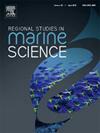Assessing stock status and abundance trends of King Mackerel (Scomberomorus cavalla) using a maturity-based approach: A comparison across local and regional scales
IF 2.1
4区 环境科学与生态学
Q3 ECOLOGY
引用次数: 0
Abstract
The king mackerel (Scomberomorus cavalla) is one of the most important fishing resources in Northeast Brazil; however, little is known about the status of its stocks, largely due to a limitation of monitoring data. In this context, simple maturity-based approaches to stock status are useful to provide a general panorama of exploitation in the absence of thorough time series. We evaluated abundance (CPUE) trends and stock-status of king mackerel at regional and local scales: the REVIZEE program (1998–2000), covering almost all of Northeast Brazil, and the REPENSAPESCA project (2019–2021), with landings recorded only in the state of Rio Grande do Norte. Both projects followed handline and gillnet fleets. Abundance trends were analyzed through Generalized Additive Models (GAM). Maturity-based stock status was used to categorize size classes into juveniles, adults below optimal catch length (Lopt), adults at Lopt and mega-spawners. Abundance trends reveal the susceptibility of the species to be caught in conditions representing the outer continental shelf, likely due to an habitat preference, and higher catch in the first semester. Stock indicators show that the most frequent maturity class were adults below Lopt, while the proportion of adults within Lopt varied between 21.5 % and 30.6 %.Although gillnetting accounted for a relatively small portion of the total fishing effort, it presented a significant concern due to the high capture rate of juvenile specimens, as this gear type is known for its low selectivity. Increasing the mesh size could help reduce the capture of undersized individuals of this species. In addition, regulating the seasonal use of gillnets by avoiding periods of recruitment in this area could further minimize juvenile bycatch. Possible mega-spawners were caught within sustainable limits. All results were similar at local and regional scales, revealing the usefulness of limited monitoring and its possible application for management at different scales.
使用基于成熟度的方法评估鲭鱼(Scomberomorus cavalla)的种群状况和丰度趋势:地方和区域尺度的比较
王鲭鱼(Scomberomorus cavalla)是巴西东北部重要的渔业资源之一;然而,由于监测数据有限,人们对其库存状况知之甚少。在这方面,在没有完整的时间序列的情况下,以简单的成熟度为基础的库存状况方法有助于提供开发情况的总体概况。我们在区域和地方尺度上评估了鲭鱼的丰度(CPUE)趋势和种群状况:revzee项目(1998-2000年),覆盖了几乎所有巴西东北部地区,以及REPENSAPESCA项目(2019-2021年),仅在巴西北部大州(里约热内卢Grande do Norte)有捕捞记录。这两个项目都采用了手绳和刺网船队。利用广义加性模型(GAM)分析了丰度趋势。基于成熟度的种群状态将大小分类为幼鱼、低于最佳渔获长度(Lopt)的成鱼、达到最佳渔获长度的成鱼和大型产卵鱼。丰度趋势揭示了在代表外大陆架的条件下捕获的物种的易感性,可能是由于栖息地偏好和第一学期较高的捕获量。存量指标显示,最常见的成熟度等级是Lopt以下的成虫,而Lopt内成虫的比例在21.5 %至30.6 %之间变化。虽然刺网在总捕鱼努力量中占相对较小的一部分,但由于幼鱼标本的高捕获率,因为这种渔具类型以其低选择性而闻名,因此引起了重大关注。增加网眼尺寸可以帮助减少捕获该物种体型过小的个体。此外,通过避免在这一地区的捕捞期来调节刺网的季节性使用,可以进一步减少副捕幼鱼。可能的巨型产卵者在可持续的限度内被捕获。所有结果在地方和区域尺度上相似,揭示了有限监测的有用性及其在不同尺度上管理的可能应用。
本文章由计算机程序翻译,如有差异,请以英文原文为准。
求助全文
约1分钟内获得全文
求助全文
来源期刊

Regional Studies in Marine Science
Agricultural and Biological Sciences-Ecology, Evolution, Behavior and Systematics
CiteScore
3.90
自引率
4.80%
发文量
336
审稿时长
69 days
期刊介绍:
REGIONAL STUDIES IN MARINE SCIENCE will publish scientifically sound papers on regional aspects of maritime and marine resources in estuaries, coastal zones, continental shelf, the seas and oceans.
 求助内容:
求助内容: 应助结果提醒方式:
应助结果提醒方式:


